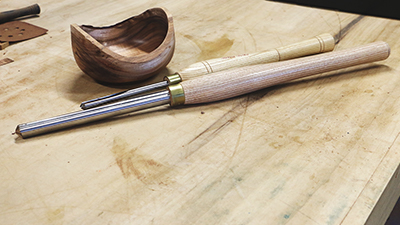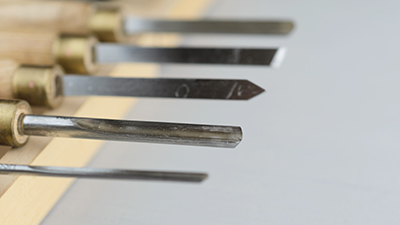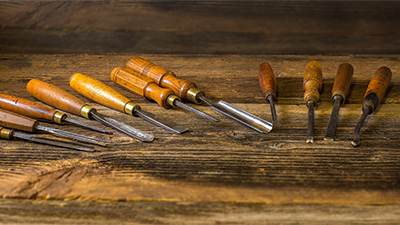Using tools that are ill-suited for the job you are doing can be the undoing of the project. If you are a woodworker, you know that there are best for certain things. Using a lathe makes the process of chiseling a piece of wood go faster, but if you don’t have the right chisels to use, then it will be a fruitless and frustrating situation.
Wood chisels should not be used with a lathe. While you can technically use them, they are not the right tools for the job. In fact, they will likely break during the lathe chiseling process. Because the chisels used with lathes are bigger and different edges, they can stand up to the high speeds used with the equipment.
We know that woodworking supplies can be expensive, which makes new woodworkers misuse their tools. But using the right supplies for the right projects the first time will save you time and money in the long run. I will walk you through the details of why normal chisels shouldn’t be used with a lathe and what tools should be used.
Can You Turn Wood With Normal Chisels?
This is one of those situations when you can do something, but you shouldn’t. You can use normal chisels with a woodturning lathe. However, it shouldn’t be done for a few reasons. The lathe moves at high speed, and that speed puts pressure on the chisel. Normal chisels can’t stand up to this pressure and will end up breaking.
There are two specific attributes of regular chisels that contribute to them breaking while using a lathe. The size of the chisel and the type of edges are both contributing factors.

Size
Lathe chisels are bigger and heartier chisels. They are specifically made to stand up to the pressure and speed they encounter during the mechanical spinning process. When you try to do this work with regular hand chisels, they break because they are smaller.
Regular chisels are made to shave the wood down slowly by hand or to use a hammer to chip the wood away. Hand chisels are wonderful and work well when used properly, but you are likely to be disappointed and frustrated if you use them with a lathe. Not to mention you will be replacing your equipment.
Another size factor that you need to consider is the handle. When you are trying to chisel wood using a lathe, you have to hold onto the chisel with both hands. If you try to use one hand, you could be injured because the chisel will fly out of your hands with the force of the lathe.
Because of this, the handles on lathe chisels are much larger to accommodate both hands. But regular chisels have small handles that can only be held by one hand.
Beveled Edges
The edges of the chisels are also different because they are essentially made for different types of woodworking. The beveled edges of the hand lathes tend to be quite thin. This is not good when they are met with speed and force that is produced by the lathe.
The beveled edges of the hand chisels tend to snap easily when encountered with the high-speed spinning lathe. This is not only frustrating and expensive in the long run, but it is also dangerous. A flying piece of metal can do damage to your body if it makes contact.
Lathe chisels have stronger and thicker edges. The materials are heartier as well. They are also designed to be able to take the speed and force of the lathe. The edges are also shaped differently, so both sides can be used at the lathe turns or reverses and turns the other way. Different types of lathe chisels will produce different designs and results.

What Chisels Should You Use With a Lathe?
There are several chisels that you can and should use when you are woodworking with a lathe. If you are just starting, then it is unlikely that you will need all of these lathe chisels and gouges. The best way to choose is to decide on a project first and then determine what other chisels you will need to complete it.
Each of these chisels does something different and offers a different design and end product. That is why it is important to know what you are hoping to make in your woodshop. Lathe chisels, or any chisel really, is not a one size fits all situation. Some can be used for multiple things, but that is not always the case.
- Spindle Roughing Gouge is used to basically make one shape into another shape. If you have a sharp-edged piece of wood that you want to round out, then you would use this chisel with the lathe.
- Spindle Gouge is used to create details. Beads, holes, and coves of some of the common details that are made with this. This chisel is one that is not interchangeable. You can’t use this chisel for anything else.
- Skew Chisel is used to give a good finish to the project. It is perfect for those of us that would rather not sand. However, you have to be careful and make sure you only use the middle part of the chisel when you are planing.
- A Parting Tool is used to make gaps or holes in the wood.
- Bowl Gouge is used for what the name implies. If you want to make a wooden bowl, then this the lathe chisel you would use.
- Swept-back Grind is similar to the bowl gouge and, in most cases, can be used interchangeably. But this chisel can produce more detail.
- Scrapers are used to make the surface smooth and work out blemishes. If you bought a starter kit for the lathe, then you may already have this chisel. It is pretty standard for kits to have it.
It is important when you are trying to decide which tool to use to do your research and understand how to use the chisel correctly. Many of these can be dangerous if they are not used as instructed or if safety precautions aren’t observed.
There is a common occurrence in lathe woodworking that can cause injuries. Catching is something that, while common, can be avoided with vigilance and the proper tools. Making sure that you chisel with the grain is the best way to prevent this.
Final Thoughts
Woodworking can be a pleasurable hobby that can even turn into a business if you become skilled enough and want to go that route. However, there are proper tools for every aspect of woodworking that are important to have.
From hand chiseling to lathing, you will need to make sure you have the proper chisels. Hand chisels should not be used with a lathe because they are not made to stand up the turning speed and force. They also don’t have handles that can accommodate two hands.
Some chisels are specifically designed for use with a lathe. Choosing the correct chisel will depend on your project. It’s encouraged that you talk to a fellow woodworker with a little more experience to help guide you through the chisel choosing process.

